Did you know that dugongs might have inspired the ancient mythical tales about mermaids?
There is one school of thought that says sailors and fishermen might have seen the dugong’s human-like, smiling faces rise above the water to breathe from afar, their heads turning, and their notched tails as they dived back in. They could have thought they were the magical sea nymphs they heard about in stories. In fact, the word ‘dugong’ is derived from the Malay for ‘lady of the sea’.
Dugongs are marine mammals under the order Sirenia – and do you know that Sirenia comes from the Greek word for mermaid: seirēn? In some other languages, siren or variants of it (e.g., sirena, sirène, sereia) translate to mermaid.
Isn’t that fascinating? Let’s not stop here but learn more about these gentle giants of the sea. What is a dugong? Is a dugong a whale, or are dugongs just manatees? They can look like they’re smiling, but are dugongs friendly? Join us in our journey of discovery, and learn the answers to these questions and more.
A welcome note from Georgina
Throughout her career Georgina has worked with a wide variety of animals such as sea lions, dolphins, birds and dugongs. She began her career volunteering and interning in local zoos and aquariums in the United Kingdom, before moving to Abu Dhabi in 2019, to join one of the Environment Agency’s partners who were involved in Abu Dhabi’s rescue dugong Malquot’s rehabilitation. She is currently a Zoological Senior Specialist within the rescue department at SeaWorld Yas Island, Abu Dhabi and the Yas SeaWorld Research and Rescue Center, where she participates in local rescue efforts as well as cares for Malquot on a daily basis.
Dugong habitats: Where do dugongs live?
Dugongs are marine animals, and they live only in saltwater. You’ll find them in protected and sheltered coastal bays, mangrove channels, and inshore islands.
Dugongs thrive in shallow waters. While they may dive into deeper waters (waters as deep as 39 meters), they spend most of their time in waters 10 meters deep.
The Arabian Gulf – particularly around the United Arab Emirates – is home to one of the largest concentrations of dugongs in the world - the second largest in fact. The largest population is in the northern coast of Australia, between Shark Bay and Moreton Bay.
The rest of the world’s dugongs are scattered around 140,000 km of coastline spanning at least 48 countries north and south of the equator. Their habitats include the Coral Triangle and the coast of East Africa. The Coral Triangle is in the Western Pacific, defined by the marine waters of Papua New Guinea, Timor Leste, Solomon Islands, Malaysia, Indonesia, and the Philippines. The coast of East Africa is a 4600-kilometer stretch from Somalia in the north to South Africa in the south.
Where are dugongs found in the UAE?
In the UAE, dugongs are primarily found in Abu Dhabi. It is estimated there are 3,000 dugongs in the emirate, especially in the protected marine ecosystems of the Al Yasat Marine Protected Area and Marawah Marine Biosphere Reserve (MMBR). Bu Tinah in MMBR, in particular, has the highest dugong population density in the world.
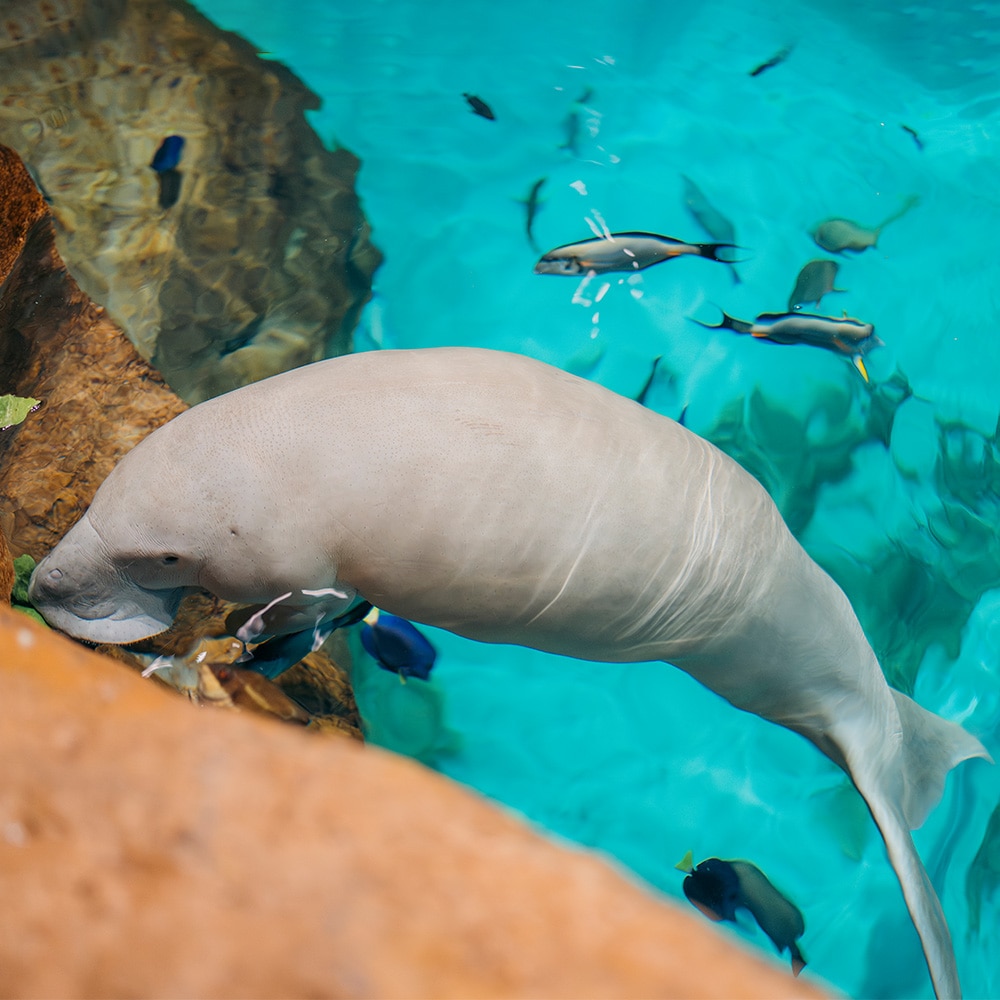
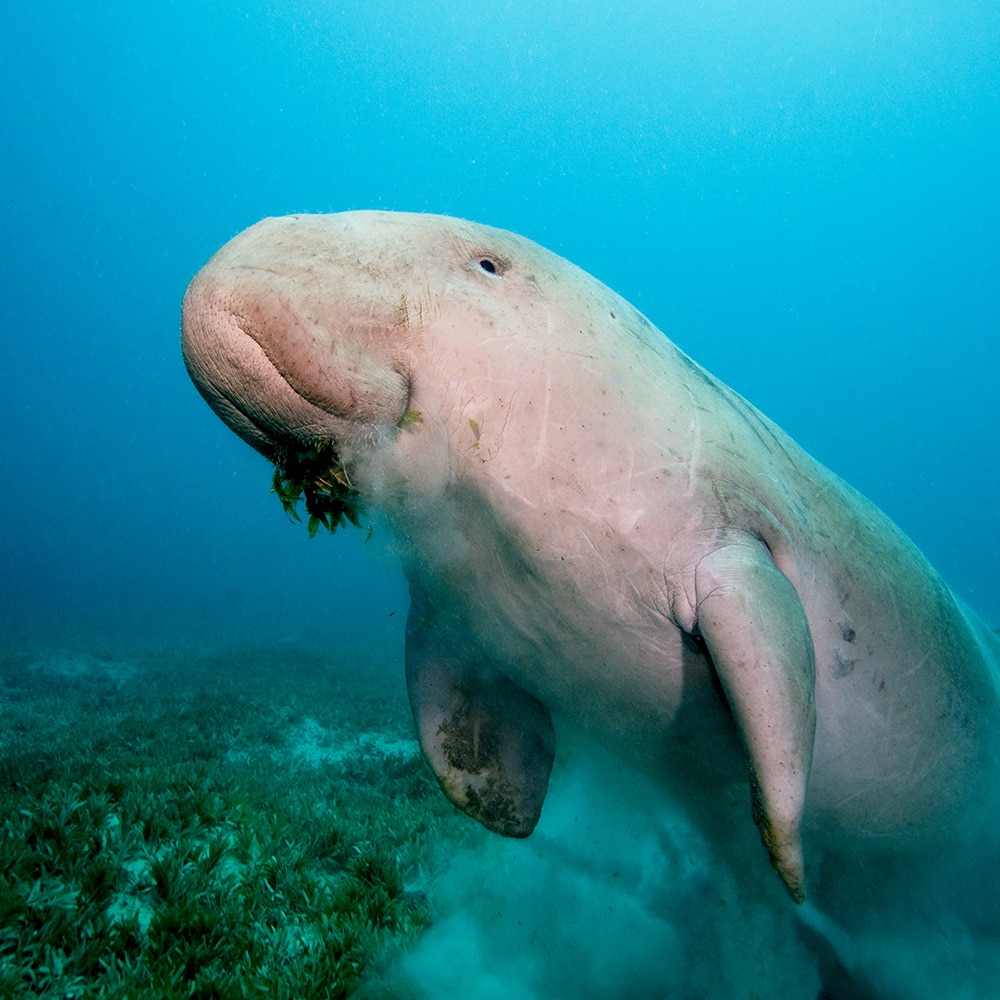
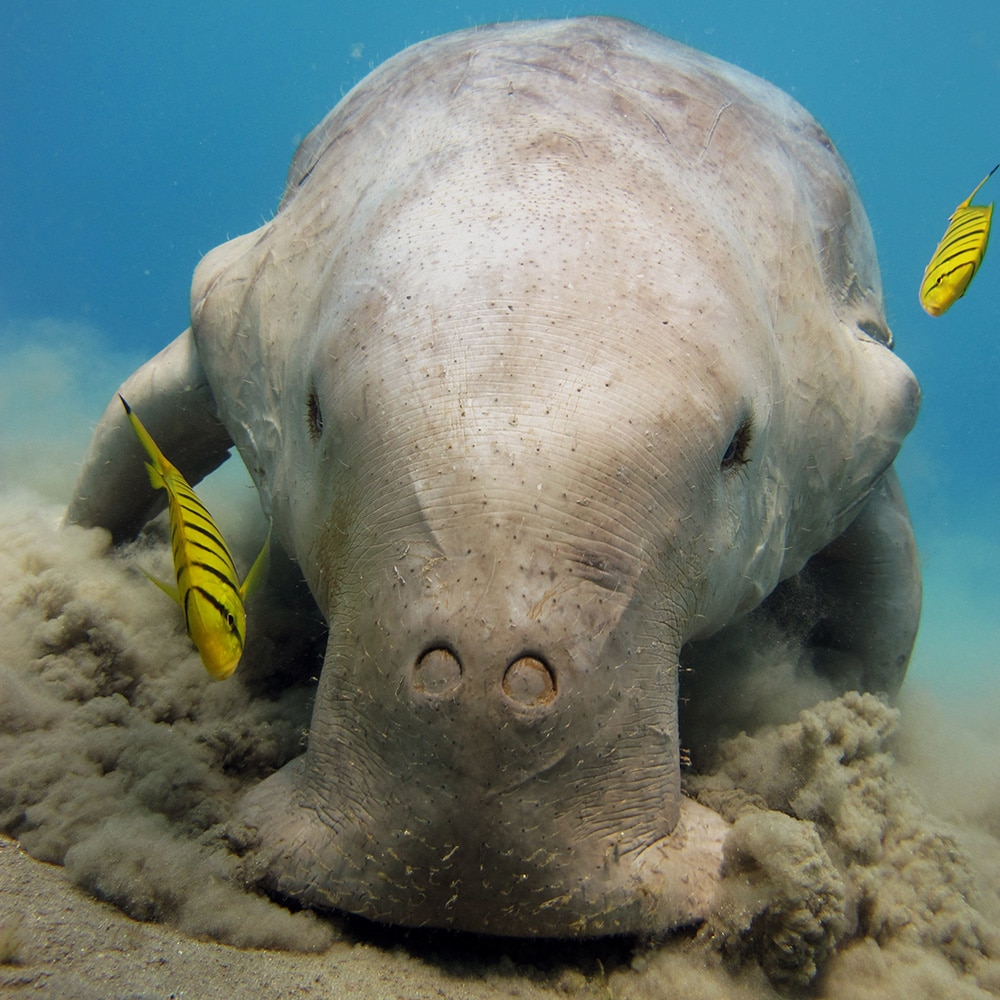
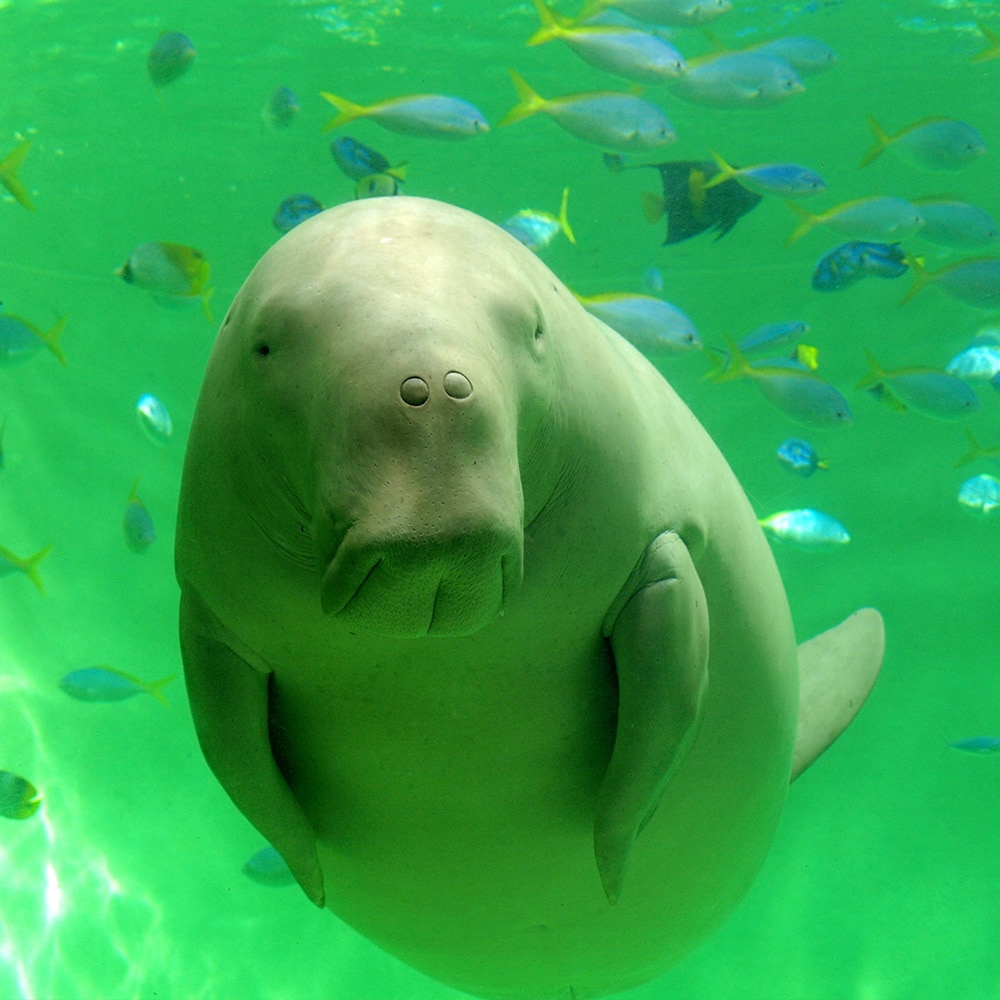
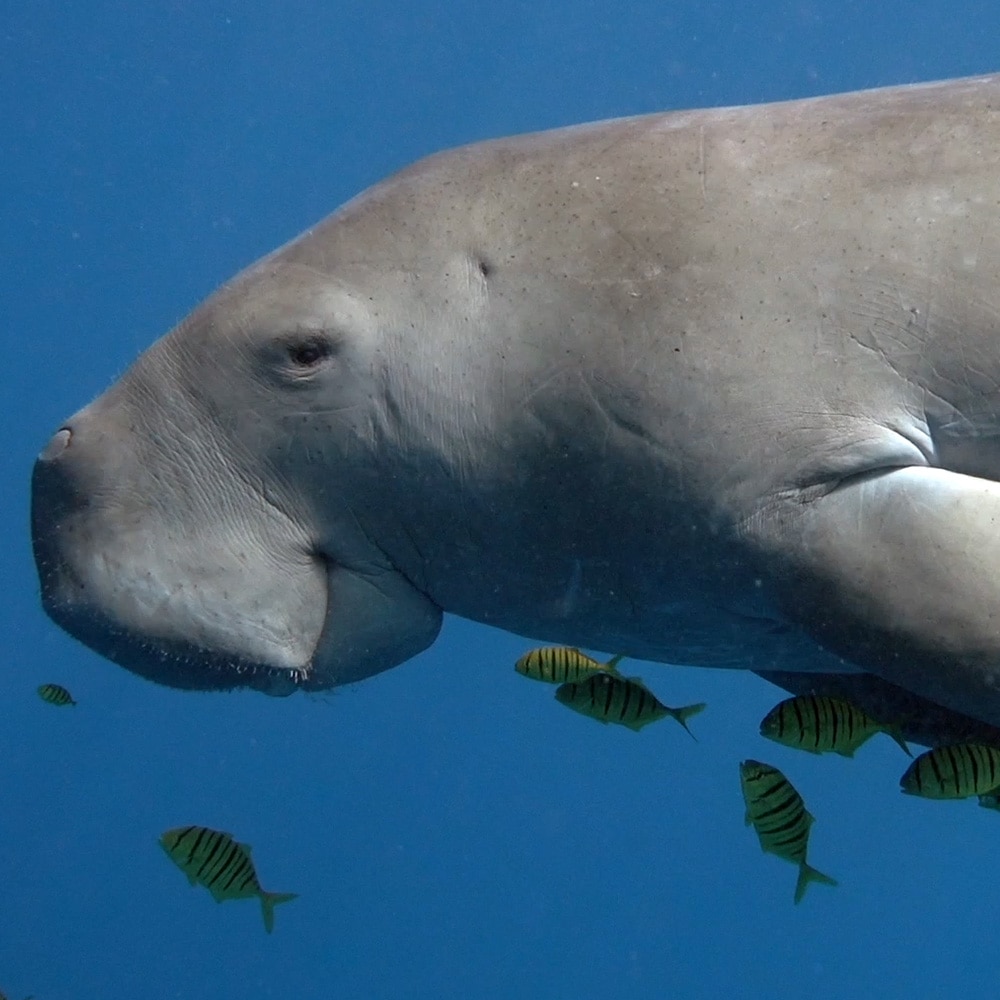
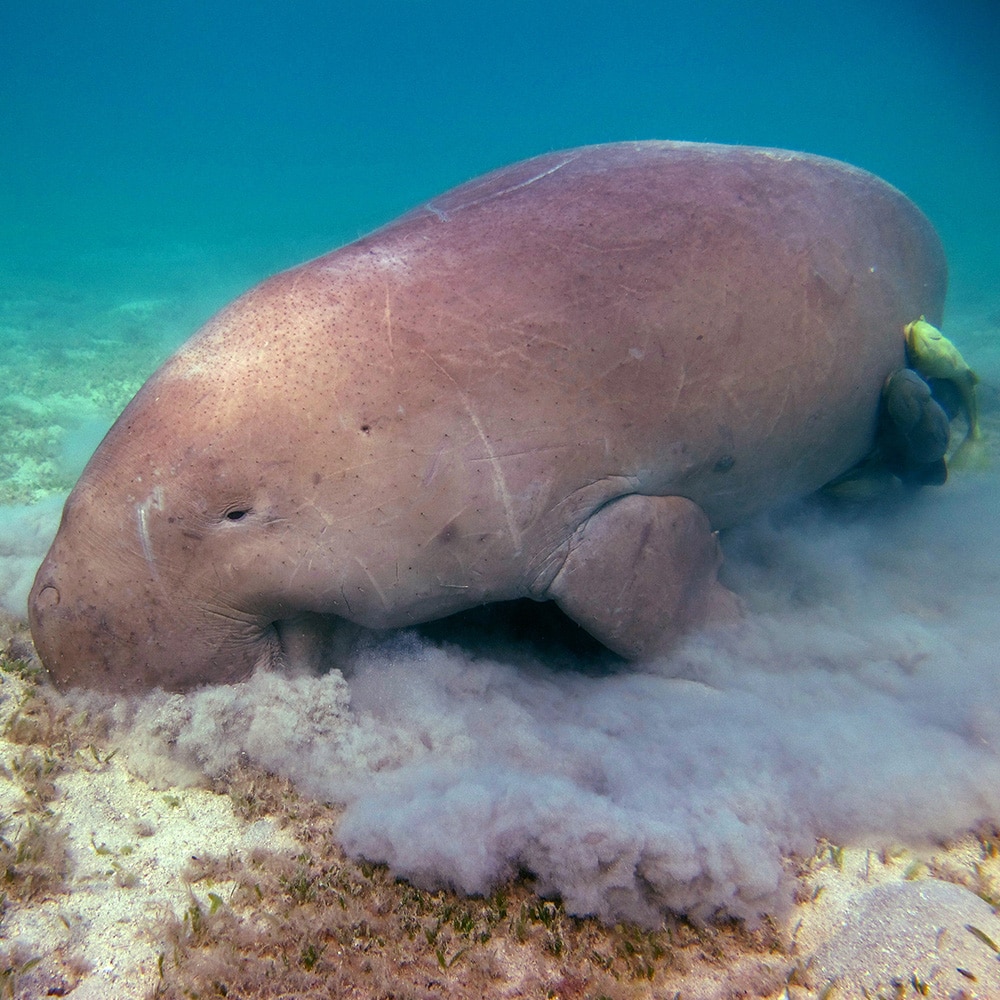
Factors influencing habitat
Dugongs primarily eat seagrass, and they don’t like the cold. Therefore, seagrass populations and water temperature are the primary factors that influence dugong habitat selection.
Seagrasses are plants and, like other plants, need sunlight for photosynthesis. This is why they live mainly in shallow water. They can go deeper, but only in exceptionally clear water. Since dugongs go where the seagrasses are, dugong populations are concentrated in shallow coastal waters.
Dugong conservation: are dugongs endangered in the UAE?
The dugong is not considered to be under threat in the UAE and Australia, thanks to the dugong-protective stances of both countries’ governments. That said, the species remains vulnerable and requires active protection, especially since the dugong population continues to decline in the urban coast of Queensland.
The International Union for Conservation of Nature (IUCN) Red List of Threatened Species says the dugong is vulnerable to extinction. The dugong has been declared functionally extinct in China and can no longer be found in Taiwan, Mauritius, and the Maldives. It has also disappeared from the Sakishima Shoto Islands of Japan, Western Sri Lanka, the Pearl River estuary in Hong Kong, some parts of Cambodia and Vietnam, and multiple islands in the Philippines.
What eats dugongs? Fully grown dugongs do not have many true natural predators. Larger aquatic animals (e.g., killer whales, sharks, saltwater crocodiles) are mainly a threat to smaller and younger dugongs, but they have been known to prey on adults as well.
However, they are vulnerable to extinction because of us humans. Human activities lead to chemical run-offs from industrial and agricultural activities, coastal infrastructure development, and dredging. These damage seagrass habitats and reduce water clarity. As seagrass cover dwindles, so does the dugong population. Human activities also lead to pollution, which threatens dugongs because they have been known to mistake plastic for seagrass.
Some indigenous people also continue to hunt dugongs for their meat, skin, bones, oil, and teeth. There even used to be one other species in the same family as the dugong – the Hydrodamalis gigasto or Steller’s sea cow – that humans hunted down to extinction.
What has the UAE done to protect dugongs?
The Environment Agency - Abu Dhabi (EAD) protects the dugong population in Abu Dhabi. The agency started its dugong conservation efforts in 1999. The EAD conducts regular aerial surveys, satellite telemetry, mortality investigation, and genetics studies to protect the dugongs in Abu Dhabi waters.
The EAD also safeguards rich, biodiverse marine areas. In 2001, the UAE government declared the waters around Marawah Island as the Marawah Marine Protected Area and, in 2005, the area around Al Yasat was declared the Al Yasat Protected Area. In 2007, the Marawah MPA became the Marawah Marine Biosphere Reserve (MMBR) after the United Nations Educational, Scientific and Cultural Organisation (UNESCO) recognized its biosphere reserve status.
Yas SeaWorld Research & Rescue Center
Our very own Yas SeaWorld Research & Rescue Center Yas Island, Abu Dhabi is dedicated to conserving the marine life, habitats and ecosystems of the Arabian Gulf. Benefitting from nearly 60 years of wildlife conservation and rescue experience from the SeaWorld brand, it is a facility for marine conservation and environmental protection research and education, as well as a center for rescue, return, and rehabilitation, pioneering an integrated approach in the MENA region.
Abu Dhabi’s Rescue Dugong: Malquot
In 2019, the Environment Agency – Abu Dhabi (EAD) found an abandoned male dugong calf at the Marawah Marine Biosphere Reserve. Separated from his mother, the barely one-month-old dugong was underweight, malnourished, and dehydrated. It looked like he was a lost cause, as dugongs depend on their mothers for at least 18 months.
EAD’s team did not let the dugong’s bleak prospects prevent them from saving the calf. EAD took him to a specialized facility, managed by Worldwide Zoo Consultants, where veterinarians and zoologists monitored his condition round-the-clock alongside EAD. They cared for him, trained him to eat seagrass, and nursed him back to good health.
The dugong rescue’s name is Malquot - Arabic for “saved” and “one whose owner is not known.” He is now several years old. He was relocated to the animal rescue and rehabilitation facility at the Yas SeaWorld Research & Rescue Center in 2023, and his current new home is in the Abu Dhabi Ocean realm at SeaWorld Yas Island, Abu Dhabi.
Know Malquot’s full rescue & rehab story
Scientific facts about the dugong: What is a dugong?
Is the dugong a whale? No, it’s not, but like a whale, it has a fluked or a notched, horizontally aligned tail. It is also a sea mammal. Thus, female dugongs have mammary glands that produce milk, and baby dugongs rely on that milk for sustenance. Like most mammals, moreover, they give birth to offspring.
The dugong is one of the only remaining species under the Dugongidae family of the order Sirenia. Here is the dugong’s detailed scientific classification:
- Kingdom: Animalia
- Phylum: Chordata
- Subphylum: Vertebrata
- Class: Mammalia
- Subclass: Theria
- Infraclass: Eutheria
- Order: Sirenia
- Family: Dugongidae
- Subfamily: Dugonginae
- Genus: Dugong
- Species: Dugong dugon
What is the English name for a dugong?
Dugongs are usually referred to as sea cows. Note, however, that manatees are also called sea cows.
Dugong vs manatee: differences between dugong and manatee
Are dugongs just manatees? No, they’re not. While dugongs and manatees are collectively called sea cows, they are different species. They do not even belong to the same family since the dugong belongs to the Dugongidae family, while manatees are of the Trichechidae family.
That said, Dugongidae and Trichechidae belong to the same order – Sirenia – so they’re close cousins. There are only four Sirenian species left: one is the dugong, while the three are these species of manatees:
- Trichechus inunguis, also known as the Amazonian manatee
- Trichechus senegalensis, the West African manatee
- Trichechus manatus, the West Indian manatee
Similarities between dugongs and manatees
The dugong and manatees share many similarities. The following are some of these:
- They are both gentle aquatic mammals with a plump, heavy body.
- They have horizontally aligned tails and paddle-like flippers.
- They both feed primarily on seagrass.
- They move slowly across seagrass meadows, grazing as they go, thus, their sea cow nickname.
Differences between dugongs and manatees
Dugongs and manatees have many differences, too. The following are some of them:
- Water habitat: The dugong does not ever venture into freshwater areas. Manatees live both in freshwater and saltwater.
- Feeding habit: The dugong often feeds on the bottom, pulling seagrass out of the seabed with their mouths. Manatees graze on seagrass from the top or near the surface.
- Mouth: The dugong has a broad, slit-like mouth. The muzzle on top makes the mouth look and function like a short trunk, and the upward-turning slit on the side makes the dugong look like it’s permanently smiling. Manatees have a shorter snout and an upper lip that is divided so the left and right sides can move somewhat independently.
- Skin: The dugong has smooth skin. Manatees have rough skin.
- Tail: The dugong has a fluked tail like that of a dolphin. Its tail looks like two lobes separated by a deep central notch. Manatees have beaver-like tails, rounded and shaped like paddles.
- Tusks: The dugong has a pair of tusk-like, overgrown incisors at the front of their mouth. This is especially obvious among adult male dugongs. Manatees don’t grow tusk-like incisors.
- Shape: The dugong has a longer and slimmer body than manatees. Its body, flippers and tail can even make it look like a dolphin from afar. Manatees have a plumper and rounder body.
- Lifespan: The dugong typically lives longer than manatees.
- Size: The adult dugong is typically shorter and lighter than adult manatees.
“The dugong is not a whale or a manatee, although it’s the latter’s close cousin. It moves and grazes like a cow and looks like it’s perennially smiling.”
What do dugongs eat?
Dugongs eat seagrass. They have a voracious appetite, consuming 64-88 pounds (28-40 kilograms) of seagrass daily. However, the dugong can eat algae when seagrass is scarce, and, on occasion, they eat invertebrates like shellfish, jellyfish, sea squirts, squid, and octopus.
Preferred seagrass
Dugongs eat almost all types of seagrass, so they will graze on whatever seagrass species are available. However, given a choice among several seagrass types, they will opt for the high-nitrogen, high-starch, and low-fiber variants.
Dugongs show a preference for seagrasses in the Halodule and Halophila genera. They also like Cymodocea rotundata (smooth ribbon seagrass), Cymodocea serrulata (serrated ribbon seagrass), Syringodium isoetifolium (noodle seagrass), and Thalassia hemprichii (Pacific turtlegrass).
Non-functional teeth
Dugongs use their trunk-like muzzles, sometimes with the assistance of their flippers, to pull whole plants into their mouths. Their habit of uprooting seagrasses is why dugongs leave grazing trails where they feed.
While they have peg-like molars in their cheeks, these are non-functional. Instead, they chew, crush, and grind food using the highly textured pads in their mouths.
- Characteristics of dugongs at a glance
- How big can dugongs get?
- How long do dugongs live?
- How old is a dugong adult?
- Are dugongs social animals?
- How do dugongs breathe?
- How does the dugong reproduce?
- Can dugongs see?
- Are dugongs friendly?
Dugong adaptations: How have dugongs adapted to survive?
Like all other animals, dugongs have adapted their bodies and behaviors to support necessary functions, improve their net energy gains, and increase their likelihood of survival. The following are some of the dugong’s adaptations.
Communication and perception
- Dugongs have tiny eyes, so they have poor eyesight. To make up for their bad vision and maintain communication with their group or herd, dugongs have exceptional hearing and tactile perception. They can even detect stimuli 492 feet away because of their keen senses.
Physiology
- Dugongs have short, stout, and bristly hair around the mouth that help them sense food.
- Dugongs have finer hair scattered all over their body to enhance their touch perception.
- A dugong’s paddle-like flippers help it steer and navigate seagrass meadows. These flippers got closer to the head through the shortening of the neck.
- Dugongs tend to be gaseous. They have evolved heady and dense bones to counter their extra buoyancy.
- The dugong's muzzle is oriented downward. This makes it easier for them to feed at the bottom of the seabed.
- The dugong has excellent salt metabolism. Its elongated kidney can produce highly concentrated urine to help the dugong maintain homeostasis in its saltwater environment and retain water to stay hydrated.
- The dugong’s round, plump body and thick back are its protection against predators. When under threat, they turn their back to would-be predators. The dugong’s back contains a thick layer of fat (i.e. blubber). It is the thickest part of the body and quite impervious to predators.
- The dugong has a tiny brain, especially relative to its size. This likely evolved for efficiency, as bigger brains consume more energy. They don’t need bigger brains because foraging on seagrass meadows does not require complex hunting strategies. Their large size also means that they do not typically fall victim to predation (and mother calves typically protect their young), so dugongs don’t need advanced evasion and defensive strategies, either.
Lifestyle
- Dugongs are semi-nomadic because they will travel for food. They go where the seagrass is. They also travel to find warmer waters during winter.
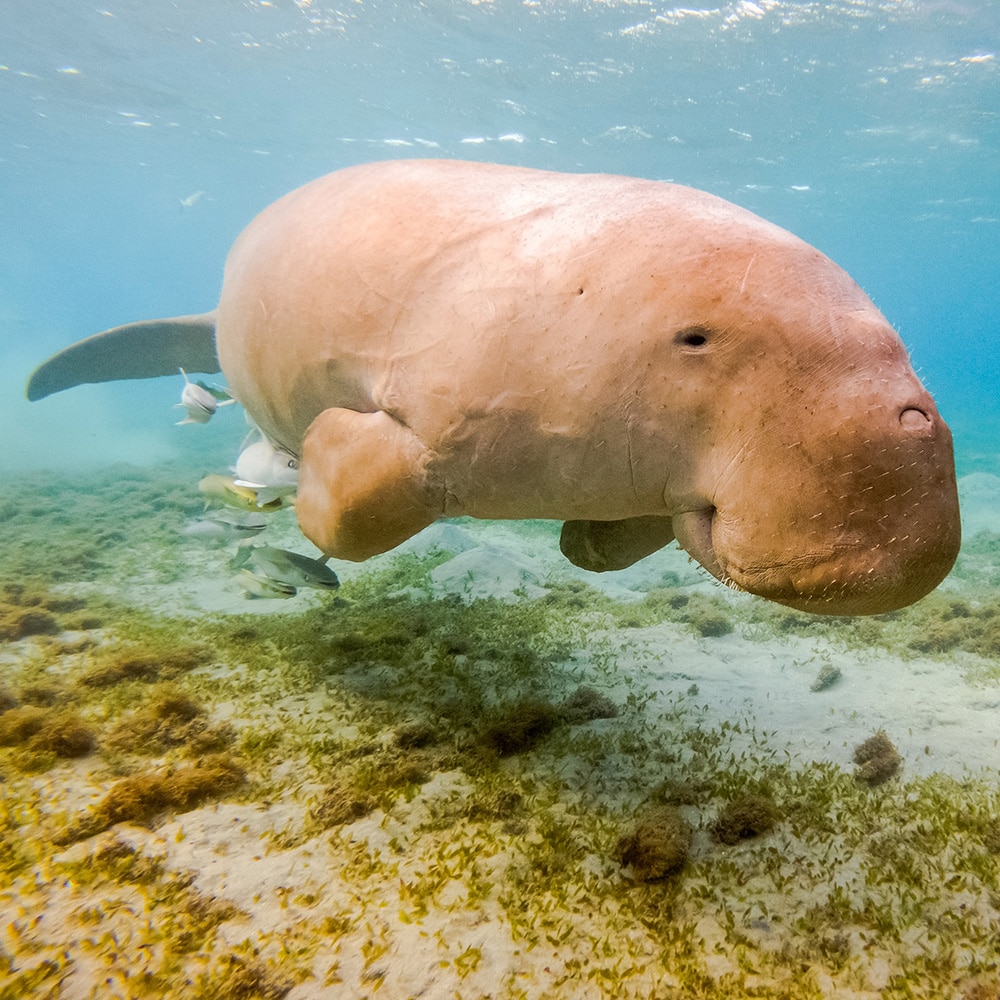
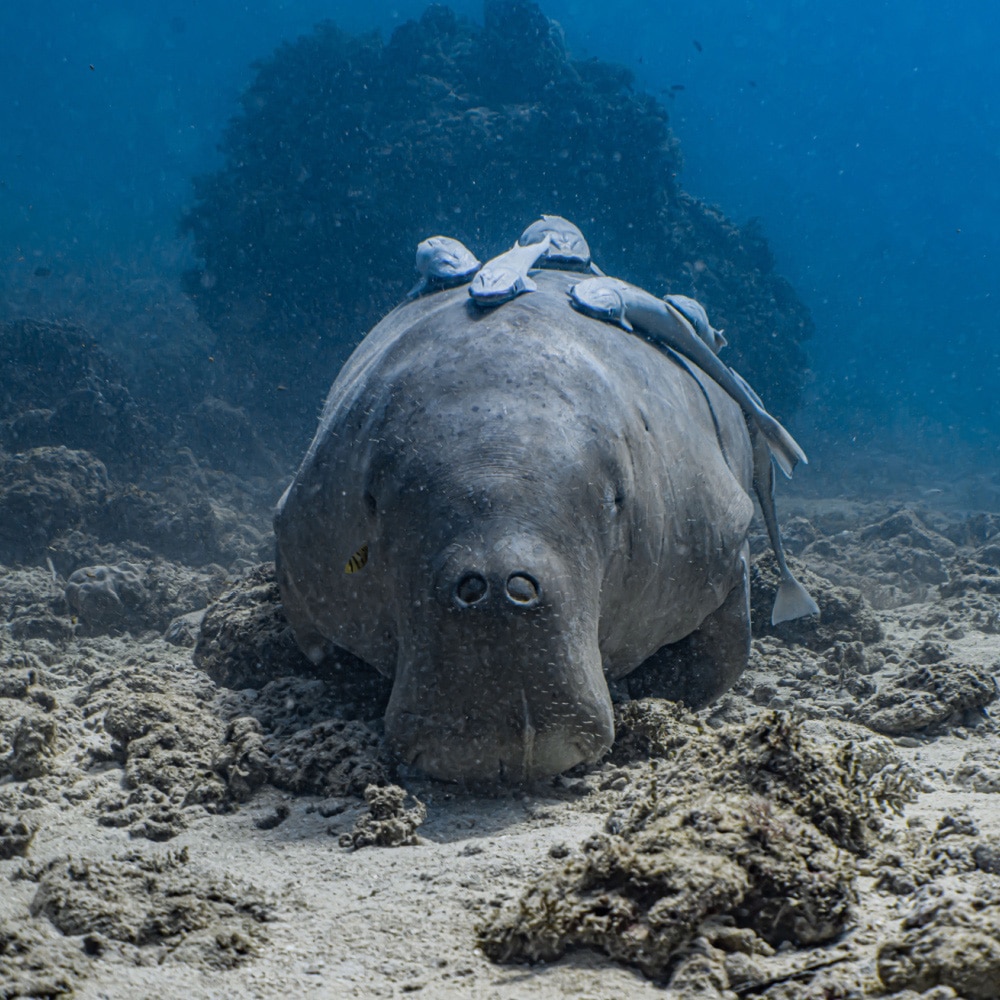
Fun facts about dugongs
The next time you and your friends talk about dugongs, impress them with your vast dugong knowledge. Here are 10 interesting facts about dugongs you can remember for your next trivia night.
- Sirenians like dugongs may be called sea cows, but they’re more related to elephants than cows. Fossils of animals from the extinct genus Moeritherium suggest that millions of years ago, the elephants’ order Proboscidea and the dugong’s order Sirenia split from a single genetic lineage.
- The dugong has a small brain. It can weigh only up to 11 ounces or 0.6875 lbs, about 0.1% of an average-sized adult dugong. In contrast, the adult human brain weighs 3 lbs, about 2% of the typical human body weight.
- The dugong’s upwardly turned mouth gives it its smiling appearance.
- In particularly shallow waters, dugongs can stand on their tails so their head can breach the waterline to breathe.
- Female dugongs tend to be bigger than male dugongs.
- Dugongs have growth rings on their tusks. Scientists count them to estimate how old a dugong is.
- Mother dugongs carry their babies for 13-15 months before giving birth. They typically give birth to just one calf each time.
- Dugong calves stick to their mothers for up to six to eight years. They nurse from their mother’s teats, found behind each paddle-like flipper (i.e. pectoral fins).
- Dugong calves can actually eat seagrasses almost immediately after birth, but suckling for 18 months or longer allows them to grow faster.
- Dugongs are such slow swimmers; they barely breach 6.2 miles per hour at their fastest.
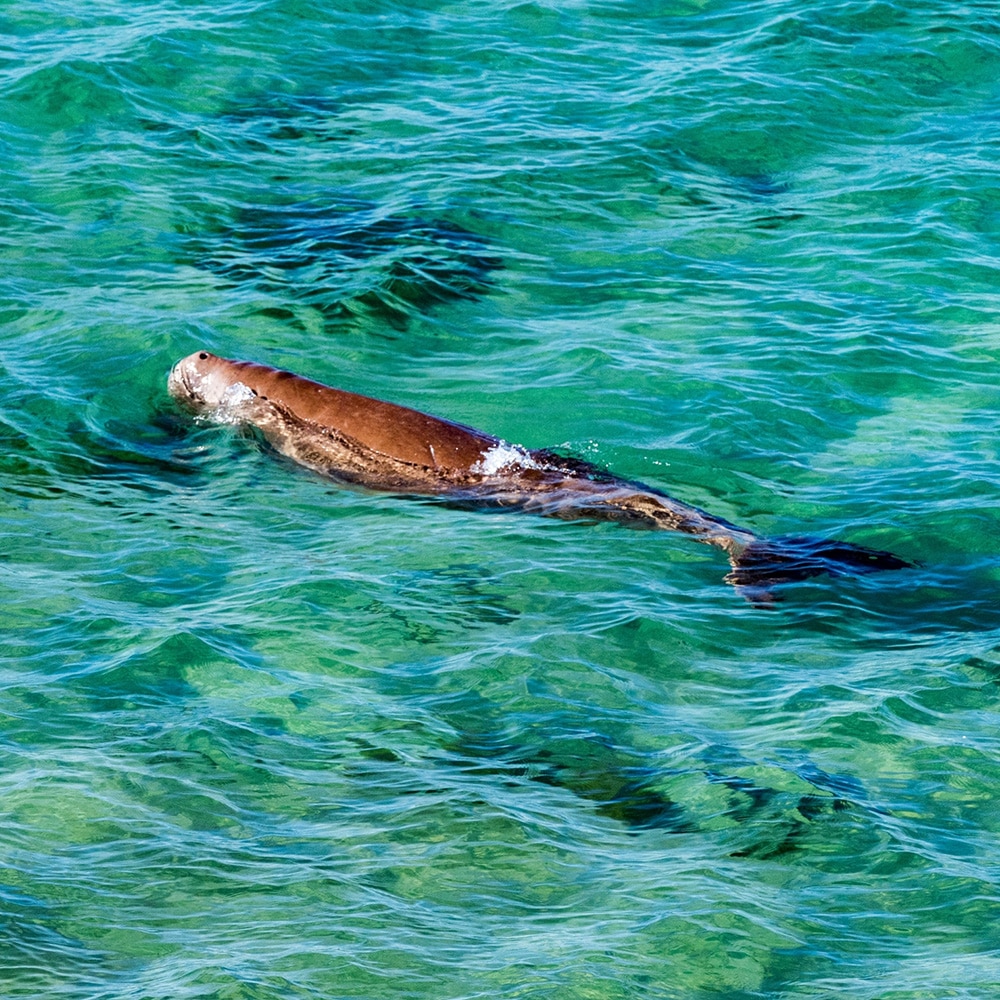
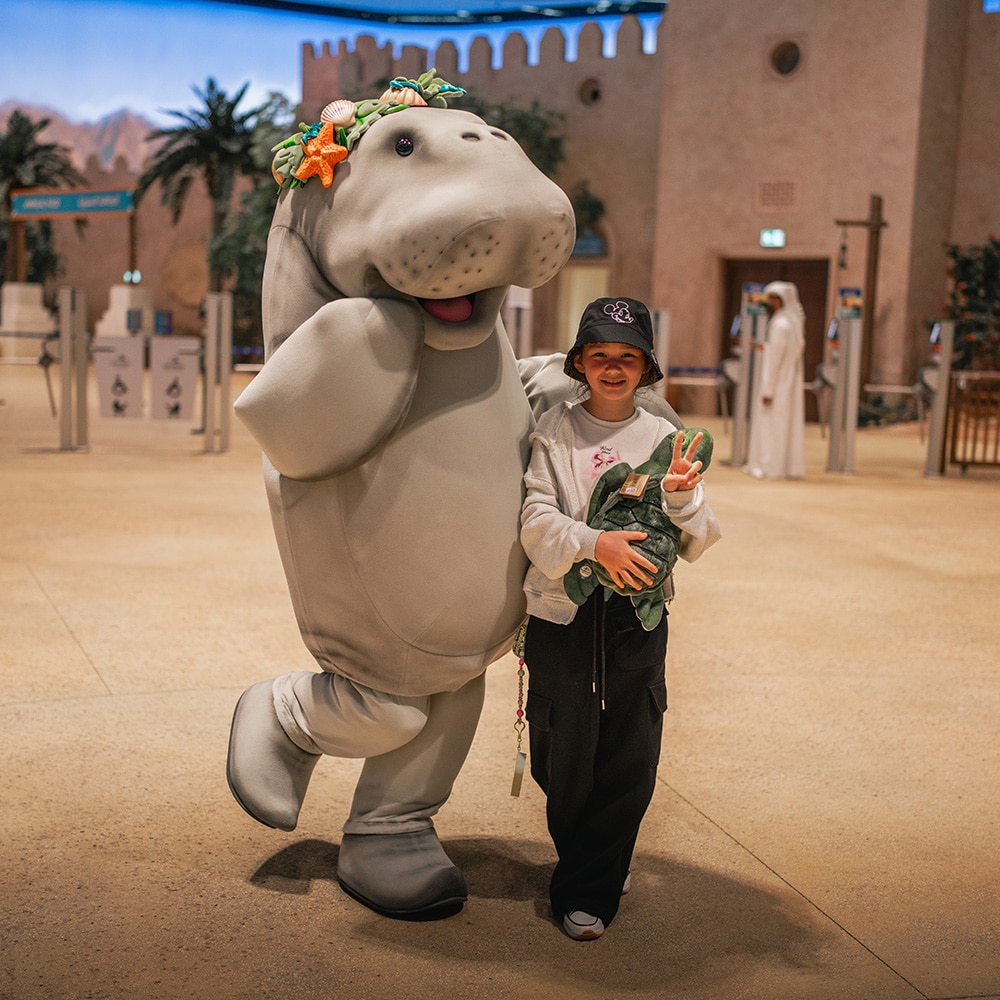
See and learn all about dugongs at SeaWorld Yas Island, Abu Dhabi
SeaWorld Yas Island Abu Dhabi is the new home of Malquot, the juvenile male dugong the EAD rescued and reared since he was a young calf.
Visit SeaWorld Yas Island, Abu Dhabi to learn more about Malquot and dugongs in general. You can even go on a once-in-a-lifetime close-up dugong encounter at Abu Dhabi Ocean.
Did you like reading our story?
If you enjoyed or learned something from this story, sign up for our newsletter and be among the first to know when a new story comes up! Please enter your email below.



